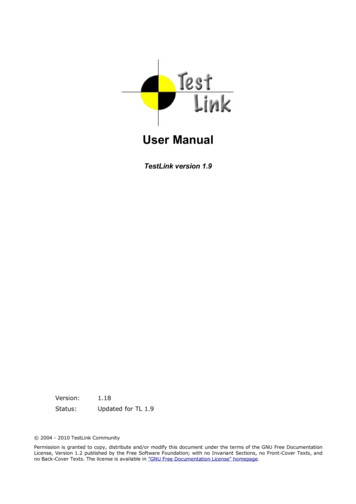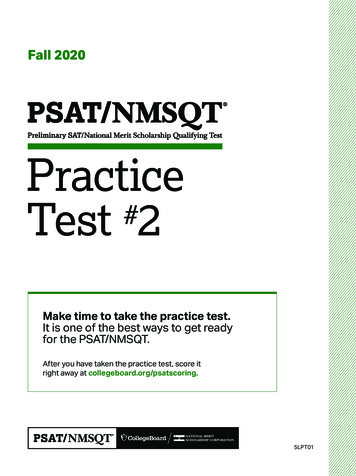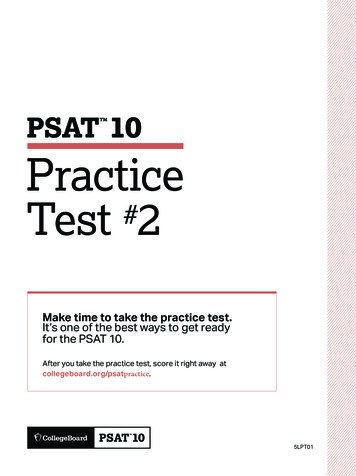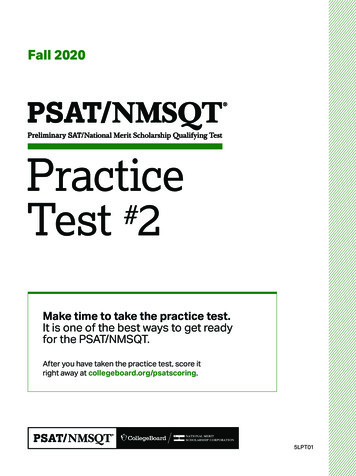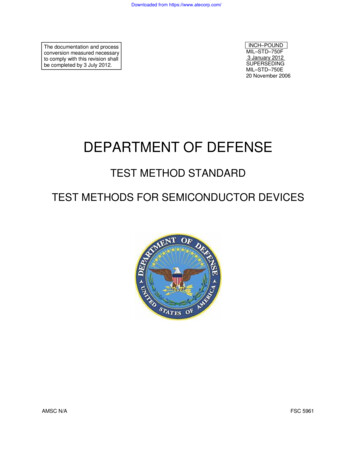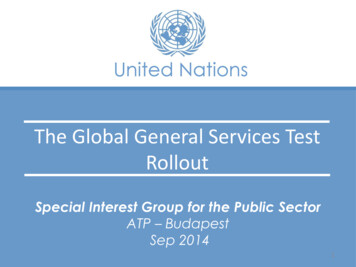
Transcription
The Global General Services TestRolloutSpecial Interest Group for the Public SectorATP – BudapestSep 20141
Background2
Context - UN Secretariat StaffSingleAssessmentASAT 44’000GeneralServiceStaff60% 1980sClericalFocusNonstandard3
Context – NewAdministrativeTestTest(ASAT)(GGST)Old Administrative StandardizedTaken on differentacross“flavors”all dutyacrossstationduty o assessmentto assessment 4GGSTASAT sstations
ChangeProcess5
Stakeholders IdentificationHiring ManagersApplicantsGGST StakeholdersHR OfficesTesting Section6
TestDevelopmentTest PilotTest RolloutTestingSectionPlan and conducta job analysiscovering a sampleof GS positions.Develop test items,test structure, testinstructions, etc.Build a version ofthe test in newonline testingsoftwareFinalize the newtest versionsHiringManagersTesting sectioninterviews andconsults with HMsas part of the jobanalysis processInterview HMs toobtain criticalincidents to focustest contentAsk HM tovolunteer servingstaff for pilotPublish article onHR portal andintranet aboutnew test.Consult with HROffice about newtest to establishtheir needsConsult with HROffices on teststructure andfeasibilityAsk HR Office toassist in piloting thenew test in all dutystationsVTCs with all dutystations HR Officesoutlining the rolloutof the new testApplicantsResearch &DevelopmentHR OfficesChange ProcessUpdate UNcareers websiteplus FAQs etc. toinform futureapplicants 7
Stakeholder Needs – Job Analysis Phase Undertook a Content Analysis of a representativesample of published GS job opening to identify themost frequently mentioned KSAs. Interviewed a represented sample of HiringManagers to establish their needs for GS staff. Generated a “high level” GS KSA profile which thetest would be modelled on.8
Test Content Development Phase GGST GMA x SJT General Mental Ability– Verbal Reasoning – multiple match items– Numerical Reasoning – multiple choose items Situational Judgment Test– Based on UN core values and competencies Weighted Score to determined passed9
GGST64(Test 12 Domains M MultipleMatch TasksC MultipleChoice # of datapoints S SituationalJudgment entationCGraphsTask5CTime lReasoning56-7STeamwork6-7SAccountability Values6-7
Validation Stage A first version of the test was piloted in April 2014 inorder to fine tune the relevant test parameters suchas level, length, contents and timing of the test. The test was given to:– a representative sample of current staff– in 9 UN entities in 6 duty stations (UNHQ, ECA, ECLAC,ESCAP, UNOG, UNOV, UN Women, UNDP, UNICEF)– from 32 countries– aged between 25-60 years– of which 75% were female11
Change Communications phase12
ChangeOutcome13
Organizational Outcomes A new truly global selection test and policy in linewith the ‘One UN’ vision. New Test welcomed by staff, in particular HiringManagers. Improved predictive validity resulting in higherquality selection of GS staff. Positive and professional recruitment experience forincoming GS staff assisting employer brand.14
Lessons Learnt15
Lessons Learnt Broad consultation upfront with relevantstakeholders (HMs and HR Offices). Be prepared to be flexible to meet stakeholderneeds. Phased rollout. Communication, Communication,Communication!16
Q&A17
GraciasMerci ﹰ ﺷﻜﺮﺍ www.un.orghttp://careers.un.org谢谢Thank YouСпасибо18
sample of published GS job opening to identify the most frequently mentioned KSAs. . GGST (Test Format) 35% 30% x weighting 6-7 6-7 . Validation Stage A first version of the test was piloted in April 2014 in order to fine tune the relevant test parameters such as level, length, contents and timing of the test. The test was given to: –a representative sample of current staff –in 9 .



